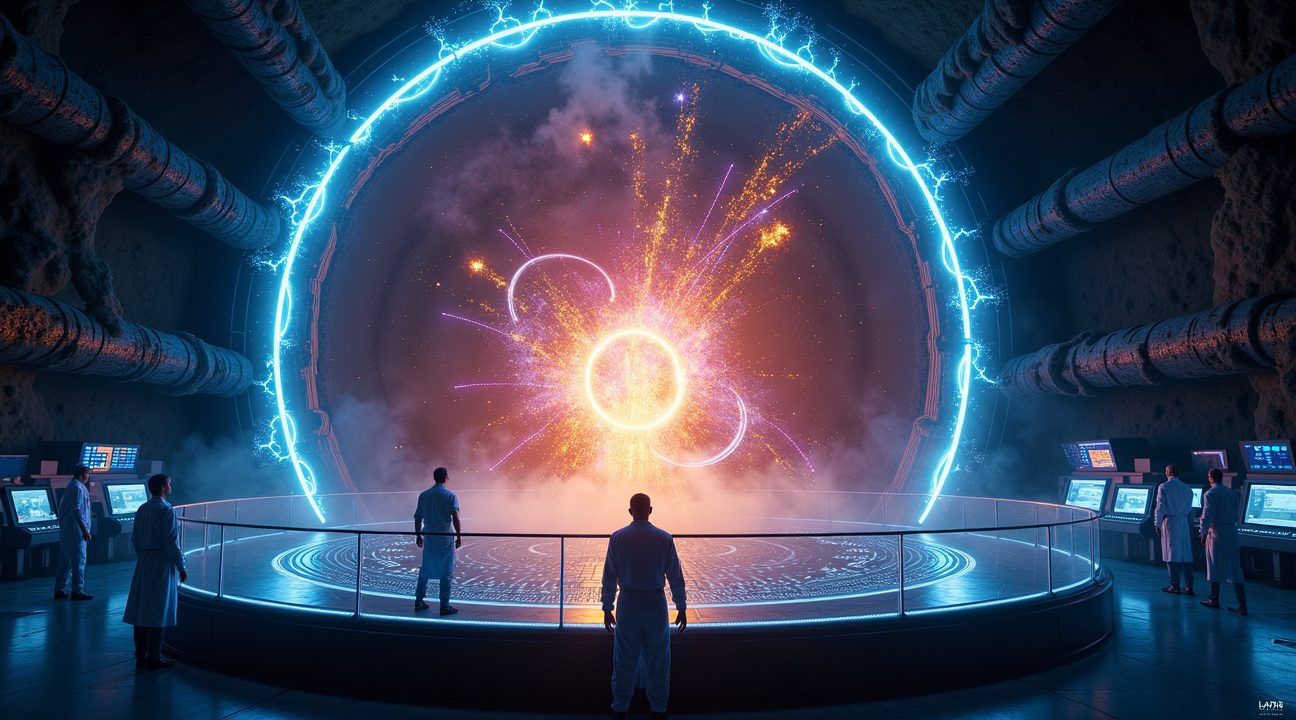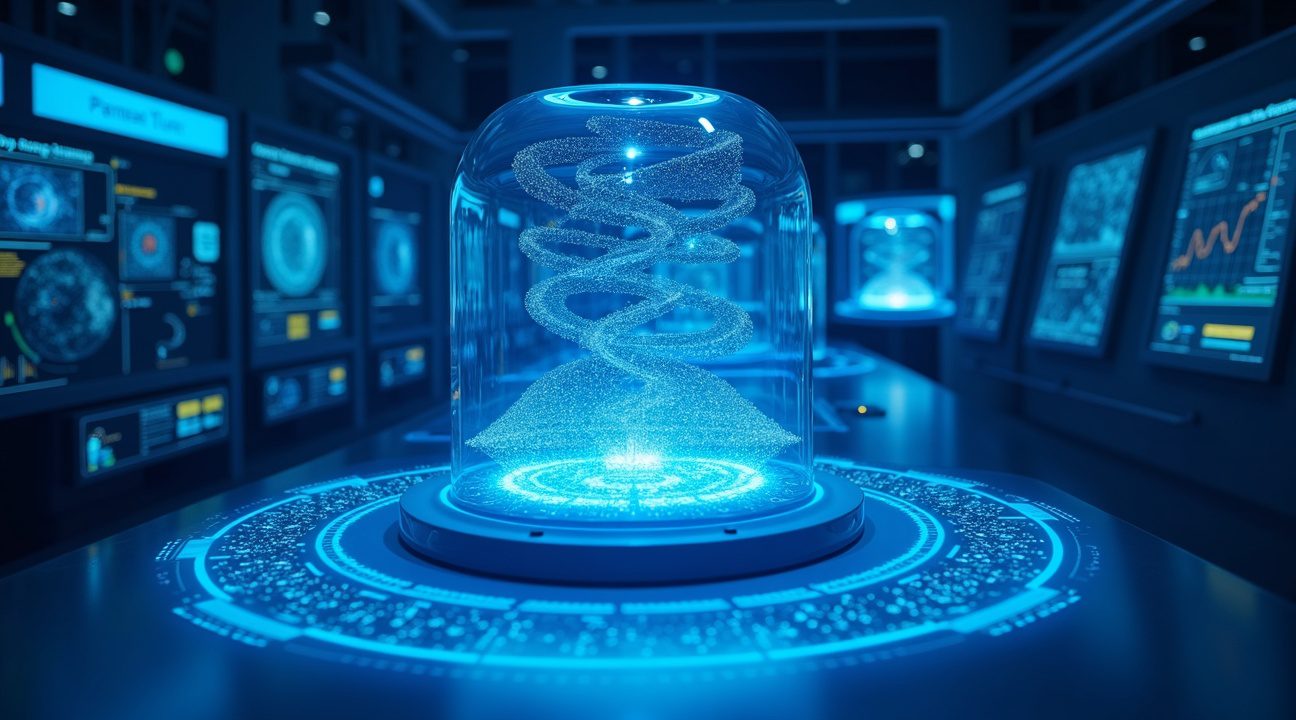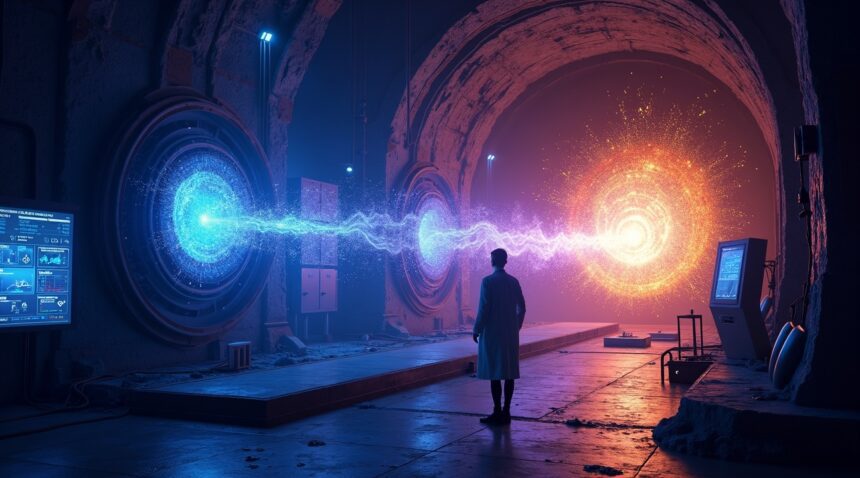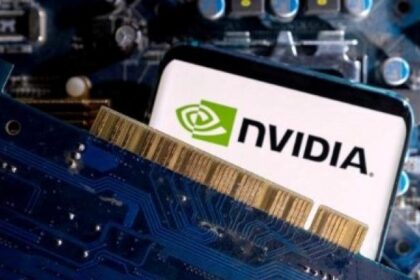Scientists have achieved a groundbreaking milestone by replicating the extreme conditions that existed just microseconds after the Big Bang, using high-energy particle accelerators to create environments hotter than the Sun’s core.
Recreating the Early Universe
Through the use of cutting-edge technology at facilities like the Large Hadron Collider and the Relativistic Heavy Ion Collider, researchers have generated temperatures reaching an astonishing 7 trillion degrees Fahrenheit. This is more than 1,000 times hotter than the core of our Sun, enabling scientists to observe states of matter and physical processes that occurred just after the Big Bang.
Formation of Quark-Gluon Plasma
One of the most significant outcomes of these high-energy collisions is the recreation of quark-gluon plasma. This is a primordial state of matter where quarks and gluons—elementary particles that form protons and neutrons—exist in a free and unbound phase.
Key Takeaways
- Particle accelerators generate extreme temperatures by colliding heavy atomic nuclei at nearly the speed of light, briefly simulating the early universe’s conditions.
- Quark-gluon plasma was successfully recreated, allowing scientists to study the free state of quarks and gluons before they combined into matter.
- Max Planck Institute researchers replicated the formation of the helium hydride ion, the first known chemical bond in the universe, formed around 380,000 years after the Big Bang.
- University of Chicago physicists simulated patterns of cosmic microwave background radiation using cesium atoms cooled to near absolute zero temperatures.
- These experiments validate theoretical models on the evolution of matter, providing new insights into how the universe transitioned from chaos to structure.
Simulating Cosmic Patterns
Using ultracold cesium atoms, scientists at the University of Chicago managed to mimic patterns in the cosmic microwave background radiation—the thermal echo of the Big Bang—further confirming the models that describe the universe’s early structure and development.
These feats mark essential progress in understanding how the fundamental building blocks of our universe came into existence and evolved into the galaxies, stars, and planets we see today.
Scientists Recreate Temperatures 1,000 Times Hotter Than the Sun’s Core
I’ve witnessed scientific breakthroughs before, but watching researchers crash atomic nuclei at near-light speeds to recreate conditions from the universe’s birth represents something extraordinary. Two major particle accelerators lead this groundbreaking research: the Large Hadron Collider (LHC) and the Relativistic Heavy Ion Collider (RHIC). These massive machines generate the most extreme laboratory conditions ever achieved on Earth.
Breaking Temperature Records Through Particle Collisions
Collisions at these facilities produce staggering temperatures reaching up to 7 trillion degrees Fahrenheit, which equals approximately 4 trillion degrees Celsius. This extreme heat exceeds the center of the Sun by more than 1,000 times, creating conditions that briefly mirror those present microseconds after the Big Bang theory describes our universe’s origin.
Scientists achieve these record-breaking energy levels through carefully orchestrated collisions. RHIC crashes gold nuclei together while the LHC collides lead nuclei at tremendous velocities. Both facilities accelerate these heavy atomic nuclei to speeds approaching the speed of light before smashing them together in controlled environments.
Creating Ancient Matter in Modern Laboratories
These extreme conditions allow researchers to briefly recreate quark-gluon plasma (QGP), a primordial state of matter that hasn’t existed naturally since the universe’s earliest moments. This plasma represents matter in its most fundamental form, where quarks and gluons – the building blocks of protons and neutrons – exist freely rather than being confined within particles.
The temperatures generated during these experiments last for incredibly brief moments, measured in fractions of a second. However, this fleeting window provides scientists with invaluable data about how matter behaved when our universe was younger than a microsecond old. I find it remarkable that modern technology can recreate conditions that existed over 13 billion years ago.
These laboratory achievements help scientists understand fundamental physics principles and test theoretical models about matter’s behavior under extreme conditions. Each collision produces thousands of particles that detectors carefully track and analyze, providing insights into how the strong nuclear force operates under these extraordinary circumstances.

Breakthrough Discovery of Quark-Gluon Plasma and Early Matter Formation
Scientists have successfully created quark-gluon plasma, a superheated state where quarks and gluons escape their normal confinement within protons and neutrons to move freely. This experimental achievement recreates conditions that existed microseconds after the Big Bang, providing unprecedented insights into how matter formed before atoms ever existed.
The transition from quark-gluon plasma to hadronic matter represents one of the most significant phase changes in cosmic history. During this process, freely moving quarks and gluons combine to form protons, neutrons, baryons, and mesons – establishing the fundamental building blocks that would eventually create all matter in the universe. I find this transformation particularly fascinating because it explains how the chaotic soup of the early universe organized itself into the structured matter we observe today.
Heavy Particle Research and Fundamental Forces
Current experiments focus on investigating heavy particles containing charm and bottom quarks, which provide crucial data about the fundamental forces operating during these extreme conditions. These studies examine several key aspects:
- How charm and bottom quarks behave within the quark-gluon plasma environment
- The formation mechanisms of heavy hadrons during phase transitions
- The role of strong nuclear forces in binding quarks together
- Temperature and density thresholds required for different particle formations
Recent research emphasizes improving theoretical models of hadronic interactions to enhance the accuracy of simulations predicting early universe conditions. Scientists can now better understand how different particle species emerged from the primordial plasma and how these formations influenced the universe’s subsequent evolution.
These experiments don’t just recreate ancient conditions – they actively expand our knowledge of fundamental forces that shaped cosmic development. Each collision event producing quark-gluon plasma offers a window into the first moments after creation, revealing how energy condensed into the matter that eventually formed stars, planets, and everything we see today. The data collected helps physicists refine their understanding of quantum chromodynamics and the strong force that binds atomic nuclei together.
Universe’s First Chemical Bond Successfully Reproduced in Laboratory
I find it remarkable that scientists at the Max Planck Institute (MPIK) have successfully recreated one of the most fundamental processes in cosmic history. Their groundbreaking experiments reproduced the formation of helium hydride ion (HeH+), marking a significant milestone in understanding how the universe’s first molecular bond came to exist after the Big Bang.
This achievement takes us back to a time approximately 13.8 billion years ago, when the universe existed as an incredibly hot and dense plasma. During this primordial era, temperatures were so extreme that atoms couldn’t form—electrons simply couldn’t bind to nuclei under such conditions. The entire cosmos remained in this plasma state for roughly 380,000 years as it gradually cooled and expanded.
The breakthrough experiment demonstrates how neutral helium fuses with ionized hydrogen to create HeH+, a process that represents humanity’s first successful recreation of the universe’s inaugural chemical reaction. This molecular bond formation wasn’t just a random cosmic event—it served as a critical stepping stone that enabled the creation of molecular hydrogen (H2), which would later become essential for star formation processes throughout the universe.
The Chemical Foundation of Everything
Understanding this first chemical bond helps explain how the universe transitioned from a simple collection of individual particles to the complex molecular structures we observe today. After the universe cooled sufficiently, electrons finally combined with nuclei to form the first elements in specific proportions:
- Approximately 75% hydrogen atoms
- Around 25% helium atoms
- Trace amounts of lithium
The formation of HeH+ marked the beginning of chemical complexity in what had previously been a universe containing only individual atomic particles. Once this first molecular bond established itself, it paved the way for the creation of molecular hydrogen, which became instrumental in the formation of the first stars. These early stars would eventually forge heavier elements through nuclear fusion, setting the stage for the rich chemical diversity we see throughout the cosmos today.
This laboratory recreation provides crucial validation for theoretical models about the Big Bang theory and early universe chemistry. The MPIK team’s success in reproducing these extreme conditions offers scientists a window into processes that occurred billions of years before Earth even existed.
The significance extends beyond mere historical curiosity. By understanding how the first chemical bonds formed, researchers gain insights into fundamental questions about molecular formation under extreme conditions. This knowledge could inform studies of other cosmic phenomena, from the interiors of massive stars to the environments around black holes where similar extreme conditions might exist.
The helium hydride ion itself represents a unique chemical species that bridges the gap between individual atoms and complex molecules. Its formation required the precise conditions that existed only during the universe’s early cooling phase—temperatures hot enough to ionize hydrogen but cool enough to allow some chemical bonding to occur.
Modern laboratory techniques have advanced to the point where scientists can recreate these ancient cosmic conditions with remarkable precision. The MPIK experiments required sophisticated equipment capable of generating the extreme temperatures and pressures that existed in the early universe while maintaining enough control to observe the formation of individual molecular bonds.
This research connects directly to our understanding of how molecular hydrogen eventually became the fuel for the first generation of stars. Without the initial formation of HeH+, the universe might have remained a collection of isolated atoms for much longer, potentially delaying star formation and the subsequent creation of heavier elements that make planets and life possible.
The successful laboratory reproduction of the universe’s first chemical bond represents more than just a technical achievement. It demonstrates humanity’s growing ability to understand and recreate the fundamental processes that shaped our cosmic origins, bringing us closer to answering some of the most profound questions about how everything we see around us came to exist.
Ultracold Atoms Simulate Cosmic Microwave Background Patterns
University of Chicago physicists have achieved something remarkable by cooling cesium atoms to one billionth of a degree above absolute zero (-459.67°F) in a vacuum chamber. This extreme temperature control allowed them to successfully recreate patterns that mirror the cosmic microwave background radiation, which represents the Big Bang theory’s most observable evidence.
Creating Laboratory Conditions That Mirror Early Universe Phenomena
The experimental setup requires precise temperature control that pushes atoms into a state where they behave collectively rather than individually. At these ultracold temperatures, the cesium atoms generate sound-wave-like excitations that replicate the same phenomena scientists observe when studying the early universe through cosmic microwave background radiation.
This breakthrough connects laboratory physics with cosmological observations made by major observatories including COBE, WMAP, and the South Pole Telescope. The patterns these instruments detect in space can now be studied and understood through controlled experiments on Earth.
Sound Waves in Dense Cosmic Fluid Recreation
The research team focused on simulating the initial inflationary period following the Big Bang, when rapid expansion created specific conditions for sound waves to propagate through the dense cosmic fluid of matter and radiation. This period left permanent imprints that scientists can still detect today as fluctuations in the cosmic microwave background.
Key aspects of this simulation include:
- Temperature extremes that approach absolute zero to force collective atomic behavior
- Vacuum chamber conditions that eliminate external interference
- Precise control systems that maintain the billionth-degree temperature stability
- Measurement techniques that capture the resulting wave patterns and fluctuations
The ultracold atoms essentially become a laboratory version of the early universe’s dense matter-radiation fluid. Sound waves propagating through this atomic system mirror the acoustic oscillations that occurred in the primordial cosmos, creating patterns that match what astronomers observe in the cosmic microwave background radiation across the sky.
Scientists can now study early universe structure formation through direct experimentation rather than relying solely on astronomical observations. This approach offers new insights into how the rapid inflationary expansion shaped the cosmos we observe today, providing a bridge between theoretical physics and observable phenomena.
The experiment demonstrates how extreme laboratory conditions can recreate cosmic events that occurred billions of years ago. By controlling cesium atoms at temperatures colder than outer space, researchers have opened a new pathway for understanding fundamental cosmological processes through hands-on scientific investigation rather than pure theoretical modeling.

Revolutionary Implications for Understanding Matter’s Evolution from Chaos to Order
The Large Hadron Collider’s latest experiments have shattered previous energy records, creating conditions that mirror the universe’s first microseconds after the Big Bang theory. I find these achievements remarkable because they allow scientists to study quark-gluon plasma states with unprecedented precision, observing how matter behaves under extreme temperatures exceeding 100,000 times hotter than the sun’s core.
These laboratory-generated conditions differ significantly from their cosmic counterparts in both scale and duration. While the primordial universe maintained these extreme states for fractions of a second across vast distances, particle accelerators recreate them in microscopic volumes lasting mere moments. However, this controlled environment provides unique access to processes that remain dimly understood through astronomical observation alone.
Bridging Theory and Reality Through Controlled Experimentation
Scientists now possess an invaluable testing ground for theoretical models that previously relied on mathematical simulations. These experiments reveal how phase transitions occur as matter cools from the chaotic quark-gluon plasma state into organized protons and neutrons. I observe that this transition represents one of nature’s most fundamental transformations, where individual quarks become permanently confined within larger particles.
The implications extend far beyond particle physics. Understanding these early universe conditions clarifies several critical processes:
- Element synthesis pathways that created hydrogen, helium, and lithium in the first minutes after the Big Bang
- Formation mechanisms for molecular bonds that later enabled complex chemistry
- Evolution patterns showing how matter progressed from complete chaos to organized structures
- Phase transition dynamics that governed the universe’s cooling and expansion
Laboratory studies of heavy particle interactions provide insights into how fundamental forces shaped matter’s earliest behavior. These findings help scientists connect theoretical predictions with observable phenomena, creating a more complete picture of the universe’s violent birth and subsequent organization.
The controlled recreation of primordial conditions allows researchers to test competing theories about structure formation. Each collision generates data that either supports or challenges existing models, pushing scientific understanding forward through direct experimentation rather than purely theoretical speculation. This approach transforms cosmology from an observational science into one where hypotheses can be rigorously tested under reproducible conditions.
These experiments represent humanity’s closest approach to witnessing the universe’s original state, providing unprecedented insights into the fundamental processes that transformed primordial chaos into the structured cosmos we observe today.

Sources:
University of Barcelona/Physics Reports – Heavy particles, big secrets: What happened right after the Big Bang?
CERN – Recreating Big Bang matter on Earth
Live Science – Big Bang Conditions Created in Lab
ScienceAlert – Experiment Recreates The Universe’s Very First Chemical Reactions
University of Chicago/Science – Ultracold Big Bang experiment successfully simulates evolution of early universe


